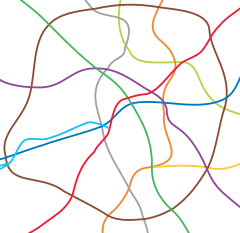Park Kultury (Koltsevaya line)
|
Park Kultury
Парк культуры |
|||||||||||||||||||||||||||||||||||||||||||||||||||||||||||||||||||||||||||||||||||||||||||||||||||||||||||
|---|---|---|---|---|---|---|---|---|---|---|---|---|---|---|---|---|---|---|---|---|---|---|---|---|---|---|---|---|---|---|---|---|---|---|---|---|---|---|---|---|---|---|---|---|---|---|---|---|---|---|---|---|---|---|---|---|---|---|---|---|---|---|---|---|---|---|---|---|---|---|---|---|---|---|---|---|---|---|---|---|---|---|---|---|---|---|---|---|---|---|---|---|---|---|---|---|---|---|---|---|---|---|---|---|---|---|---|
| Moscow Metro station | |||||||||||||||||||||||||||||||||||||||||||||||||||||||||||||||||||||||||||||||||||||||||||||||||||||||||||
 |
|||||||||||||||||||||||||||||||||||||||||||||||||||||||||||||||||||||||||||||||||||||||||||||||||||||||||||
| Location | Ostozhenka Street, Khamovniki District, Central Administrative Okrug |
||||||||||||||||||||||||||||||||||||||||||||||||||||||||||||||||||||||||||||||||||||||||||||||||||||||||||
| Coordinates | 55°44′09″N 37°35′29″E / 55.7357°N 37.5915°ECoordinates: 55°44′09″N 37°35′29″E / 55.7357°N 37.5915°E | ||||||||||||||||||||||||||||||||||||||||||||||||||||||||||||||||||||||||||||||||||||||||||||||||||||||||||
| Owned by | Moskovsky Metropoliten | ||||||||||||||||||||||||||||||||||||||||||||||||||||||||||||||||||||||||||||||||||||||||||||||||||||||||||
| Line(s) | 5 Koltsevaya Line | ||||||||||||||||||||||||||||||||||||||||||||||||||||||||||||||||||||||||||||||||||||||||||||||||||||||||||
| Platforms | 1 | ||||||||||||||||||||||||||||||||||||||||||||||||||||||||||||||||||||||||||||||||||||||||||||||||||||||||||
| Tracks | 2 | ||||||||||||||||||||||||||||||||||||||||||||||||||||||||||||||||||||||||||||||||||||||||||||||||||||||||||
| Connections | Trolleybus: Б, 10, 28, 31, 31к, 79 | ||||||||||||||||||||||||||||||||||||||||||||||||||||||||||||||||||||||||||||||||||||||||||||||||||||||||||
| Construction | |||||||||||||||||||||||||||||||||||||||||||||||||||||||||||||||||||||||||||||||||||||||||||||||||||||||||||
| Structure type | Deep pylon tri-vault | ||||||||||||||||||||||||||||||||||||||||||||||||||||||||||||||||||||||||||||||||||||||||||||||||||||||||||
| Depth | 40 metres (130 ft) | ||||||||||||||||||||||||||||||||||||||||||||||||||||||||||||||||||||||||||||||||||||||||||||||||||||||||||
| Platform levels | 1 | ||||||||||||||||||||||||||||||||||||||||||||||||||||||||||||||||||||||||||||||||||||||||||||||||||||||||||
| Parking | No | ||||||||||||||||||||||||||||||||||||||||||||||||||||||||||||||||||||||||||||||||||||||||||||||||||||||||||
| Other information | |||||||||||||||||||||||||||||||||||||||||||||||||||||||||||||||||||||||||||||||||||||||||||||||||||||||||||
| Station code | 076 | ||||||||||||||||||||||||||||||||||||||||||||||||||||||||||||||||||||||||||||||||||||||||||||||||||||||||||
| History | |||||||||||||||||||||||||||||||||||||||||||||||||||||||||||||||||||||||||||||||||||||||||||||||||||||||||||
| Opened | 1 January 1950 | ||||||||||||||||||||||||||||||||||||||||||||||||||||||||||||||||||||||||||||||||||||||||||||||||||||||||||
| Rebuilt | February 2011 – 30 March 2011 | ||||||||||||||||||||||||||||||||||||||||||||||||||||||||||||||||||||||||||||||||||||||||||||||||||||||||||
| Previous names | Park Kultury Imeni Gorkogo | ||||||||||||||||||||||||||||||||||||||||||||||||||||||||||||||||||||||||||||||||||||||||||||||||||||||||||
| Services | |||||||||||||||||||||||||||||||||||||||||||||||||||||||||||||||||||||||||||||||||||||||||||||||||||||||||||
|
|||||||||||||||||||||||||||||||||||||||||||||||||||||||||||||||||||||||||||||||||||||||||||||||||||||||||||
|
|||||||||||||||||||||||||||||||||||||||||||||||||||||||||||||||||||||||||||||||||||||||||||||||||||||||||||
| Location | |||||||||||||||||||||||||||||||||||||||||||||||||||||||||||||||||||||||||||||||||||||||||||||||||||||||||||
Park Kultury (Russian: Парк культу́ры) is a Moscow Metro station in the Khamovniki District, Central Administrative Okrug, Moscow. It is on the Koltsevaya Line, between Oktyabrskaya and Kiyevskaya stations. Park Kultury opened on 1 January 1950.
The station is a standard pylon-trivault, that was built in the flamboyance of the 1950s. Architect Igor Rozhin (who would then design the Luzhniki Stadium) applied a classic sport recreational theme to match the connotation with the ancient-Greek inspired transfer station. This includes large and imposing pylons faced with grey marble that came directly from Georgia. The floor is laid with black and grey granite tiles imitating a carpet. The walls are faced with white marble and labrodite. Decoratively the station contains 26 circular bas-reliefs by Iosif Rabinovich which depict sporting and other leisure activities of the Soviet youth.
The white vault of the station contains intricate geometry which repeat that of the pylons, and along the apex are suspended a set of intricate hexagonal chandeliers. Rozhin later admitted that he made a grave error in choosing to place the chandeliers amid the pylons, not between them, that way he would have avoided giving the bas-reliefs a double shadow. At the end of the station is a large marble wall with a small profile bas-relief of Maxim Gorky. The station was initially called "Park Kultury imeni Gorkogo" (Парк Культуры имени Горького) but during the 1980 Moscow Olympics this was shortened as the Russian announcements were repeated in English and French during the games. After the Olympics the shorter name was retained. The original long form appears in bronze letters next to Gorky's image.
...
Wikipedia


